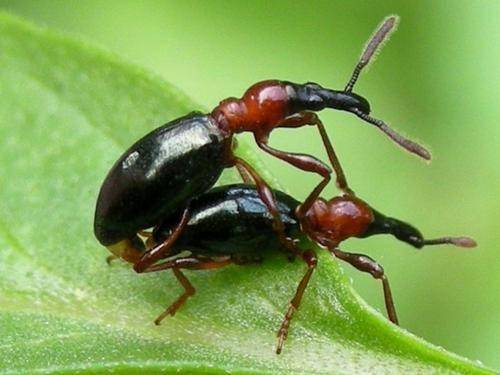Sweet potato is one of the most important food crops in the world, providing humans with rich carbohydrates and dietary fiber. However, the cultivation of sweet potato faces many threats from pests and diseases, among which the sweet potato ant weevil (Cylas formicarius) is a very destructive pest. Although they do not directly harm humans, their harm can indirectly affect human life through agricultural production, food safety and economic losses. This article will discuss in detail the harm of the sweet potato ant weevil and its prevention and control measures.

The sweet potato ant weevil, scientifically known as Cylas formicarius, is a weevil pest that specifically harms sweet potato crops. They are small in size, black or dark blue in color, and are named "sweet potato ant weevil" because of their ant-like appearance.
The life cycle of sweet potato ants includes four stages: egg, larvae, pupae and adults:
Egg stage (3-7 days): The female insect lays eggs in the cracks of the sweet potato tubers or stems.
Larva stage (10-15 days): After the larvae hatch, they will eat inside the sweet potato, causing the tubers to rot.
Pupa stage (7-10 days): The larvae enter the soil or tubers to pupate.
Adult stage (3-6 months): Adults can move on sweet potato leaves and stems, chewing plants and looking for new egg-laying sites.
Adults have strong flying ability and can spread quickly in sweet potato fields, increasing the difficulty of prevention and control.
Although sweet potato ants will not attack humans directly, the agricultural, food safety and economic impacts they bring will eventually affect the quality of life and health of humans.
The larvae of the sweet potato ant bore into the tubers, causing black tunnel-like holes to appear on the surface of the sweet potatoes, making them lose their commercial value. At the same time, the larvae's activities inside the sweet potatoes will cause secondary infection, leading to fungal and bacterial rot, causing the entire sweet potato to deteriorate.
Severely affected sweet potato plants will turn yellow and wilt, and eventually fail to grow normally, resulting in a 30%-70% reduction in yield, or even a total crop failure.
During the storage of sweet potatoes, the rot of the affected tubers will spread further, affecting the storage of the entire warehouse and causing greater losses.
Sweet potatoes may produce harmful molds, such as aflatoxin, after rotting. This toxin can cause liver damage, and long-term consumption may increase the risk of liver cancer.
Sweet potatoes eaten by sweet potato ants have a deteriorating taste and may carry bacteria or insect eggs, which may cause gastrointestinal discomfort or even food poisoning after consumption.
Sweet potatoes are the main source of income for many farmers. The invasion of sweet potato ants has led to a decline in production and reduced farmers' income.
Due to the serious pests, farmers need to invest more money in pesticide control, improved planting methods, and strengthened storage management, which increases agricultural costs.
Large-scale sweet potato ant weevils will lead to a reduction in the supply of sweet potatoes, thereby affecting market prices.
As one of the main grains, the price increase of sweet potatoes may affect the lives of people in areas that rely on sweet potatoes as their staple food.
Sweet potato ant weevils spread rapidly through the circulation, transportation, and planting of affected sweet potatoes, which may affect the sweet potato industry in multiple regions and increase the government's epidemic prevention costs.
In the face of the serious damage caused by sweet potato ants, comprehensive prevention and control measures need to be taken, including agricultural prevention, biological prevention, physical prevention and chemical prevention.
Crop rotation: Avoid continuous planting of sweet potatoes on the same land to reduce the residual eggs.
Healthy seedlings: Choose uninfected seed potatoes to avoid bringing pests into the fields.
Deeply bury the damaged sweet potatoes: Clean the damaged sweet potatoes in time and bury them deeply to reduce the spread of pests.
Releasing parasitic wasps (such as egg parasitic wasps) can effectively control the reproduction of sweet potato ants.
Use pathogens (such as Bacillus thuringiensis) to infect sweet potato ants and reduce their population.
Covering insect-proof nets: Cover the surface of the sweet potato field with insect-proof nets to reduce the chance of adult insects laying eggs.
Using light traps: Use trapping lights at night to reduce the number of adult insects.
Use low-toxic and high-efficiency insecticides, such as imidacloprid, avermectin, etc., but pesticide residues must be strictly controlled.
Use biological pesticides to reduce environmental pollution and impact on human body.
Although sweet potato ants do not directly harm humans, their impact on agricultural production, food safety and economy cannot be ignored. They can lead to reduced sweet potato yields, food contamination, reduced farmers' income, and even affect market supply and price stability. Therefore, comprehensive prevention and control measures, from agricultural management to biological control, and then to physical and chemical methods, can effectively control the harm of sweet potato ants and ensure the stable production of sweet potatoes.
animal tags: Cylas-formicarius
We created this article in conjunction with AI technology, then made sure it was fact-checked and edited by a Animals Top editor.